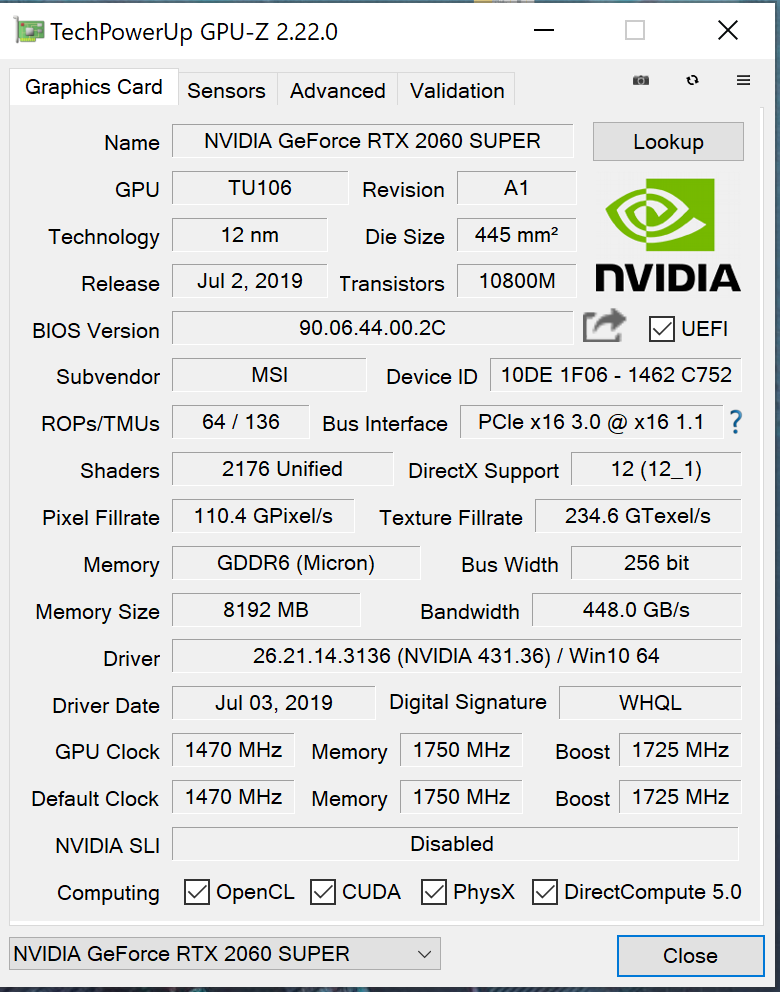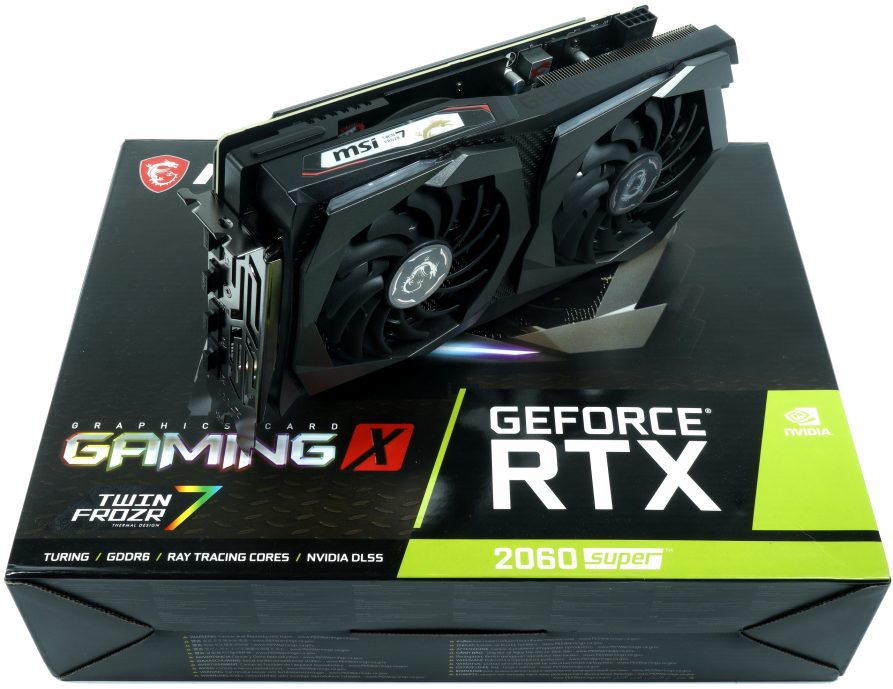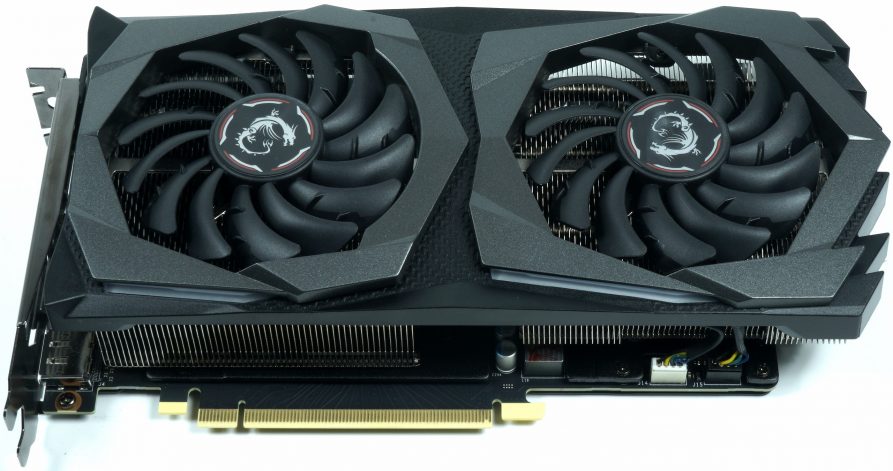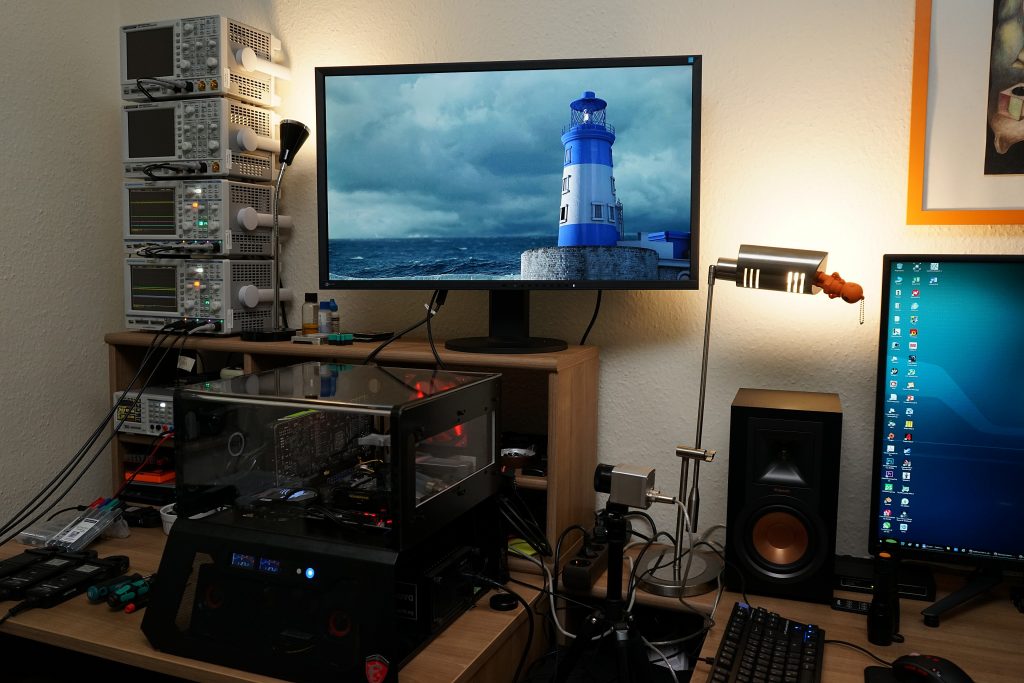I was looking forward to the respective interpretation of the board partner cards for the GeForce RTX 2060 Super and today I just start with an MSI RTX 2060 Gaming X, because it was the first card to arrive in the lab. And first of all: I was not disappointed, but unfortunately I also had to find out once again where Nvidia has rebuilt the conscious wall in order to protect its own products. See heading. But I will come to this later, because the board partner card is in the foreground and no personal sensitivities.
In terms of price, MSI sorts this card at the top of the in-house RTX 2060, so it would be used instead of the current approx. 455 Euros for this model certainly also significantly cheaper if it is to be a smaller of the RTX cards. But you don't just buy the chip, but also the whole thing. And it is at this point that our expedition into the realm of added value begins. The next pages will have to show whether we can get out of there safely.
Compared to the full VERSION TU106-400 on the RTX 2070, the TU106-410 of the card is reduced to 2176 CUDA cores, 272 tensor cores, 34 RT cores, 136 TMUs and 64 ROPs. The card has (officially) clock frequencies in the range of 1470 MHz (base clock) and 1725 MHz (boost), but clocks much higher in practice. Compared to the RTX 2060, the MSI RTX 2060 Super Gaming X again has 4 MB L2 cache instead of the three MB of the simple RTX 2060.
Uncircumcised, the TU106-410 also retains the same 256-bit memory bus as the TU106-400, which has eight 1 GB GDDR6 memory modules with 14 Gb/s data rate, resulting in bandwidth of up to 448 GB/s. As with the GeForce RTX 2070, NVLink support in this price range is long gone. A rogue who thinks evil in it, but what's the point?
Otherwise, everything I have already written in the launch articles for the GeForce RTX 2070 FE and the GeForce RTX 2060 FE applies. And if you want to find out more about all the RTX features in detail, please refer to my long basic article "Nvidia GeForce RTX 2080 Ti and RTX 2080 – what is really hidden behind Turing" on the subject of RT. This, too, is worth reading and certainly worth it.
Although the TU106 is the least complex Turing-based GPU to date, its 445 mm2 chip contains no less than 10.8 billion transistors. That's still huge for what Nvidia might once have considered the center of its portfolio. In comparison, the GP106, i.e. the "Midrange Pascal", was a small 200 mm2 chip with 4.4 billion transistors.
Unboxing and technical data
The map follows the typical MSI design language and does not set any accents in terms of colour. This is then later provided by an RGB lettering on the top, but there is no more. The TwinFrozr design of the 7th Generation has no secrets and actually (almost) everything is as usual. A very dark, anthracite-coloured plastic cover and the usual 2.5 slot design leave quite a little adrenaline.
But appearances don't matter anyway and there will certainly be people who would rather not have it applied quite so thickly. Three DisplayPort ports and one HDMI 2.0 complete the slot bezel.
Here's a first look at the latest version of GPU-Z:

Instead of my own analysis, however, I have at least the technical data at a glance, for which one does not need any physically existing test objects:
| GeForce RTX 2060 Super |
MSI RTX 2060 Super Gaming X |
GeForce RTX 2060 FE | GeForce RTX 2070 FE |
GeForce GTX 1070 FE |
|
| Architecture (GPU) |
Turing (TU106-410) | Turing (TU106-410) | Turing (TU106-300) | Turing (TU106-400) | Pascal (GP104) |
| CUDA Cores |
2176 | 2176 | 1920 | 2304 | 1920 |
| Tensor Cores |
272 | 272 | 240 | 288 | N/A |
| RT Cores |
34 | 34 | 30 | 36 | N/A |
| Texture Units |
136 | 136 | 120 | 144 | 120 |
| Base Clock Rate |
1470 MHz | 1470 | 1365 MHz | 1410 MHz | 1506 MHz |
| GPU Boost Rate |
1650 MHz | 1725 | 1680 MHz | 1710 MHz | 1683 MHz |
| Storage expansion |
8GB GDDR6 | 8GB GDDR6 | 6GB GDDR6 | 8GB GDDR6 | 8GB GDDR5 |
| Storage bus |
256-bit | 256-bit | 192-bit | 256-bit | 256-bit |
| Bandwidth |
448 GB/s | 448 GB/s | 336 GB/s | 448 GB/s | 256 GB/s |
| Rops |
64 | 64 | 48 | 64 | 64 |
| L2 Cache |
4 MB | 4 MB | 3 MB | 4MB | 2MB |
| Tdp |
175 W | 180 watts | 160 W | 185W | 150w |
| Transistors |
10.8 billion | 10.8 billion | 10.8 billion | 10.8 billion | 7.2 billion |
| The size |
445 mm2 | 445 mm2 | 445 mm2 | 445 mm2 | 314 mm2 |
| Sli |
No | No | No | No | Yes (MIO) |
Test system and measurement methods
I have described the test system and the methodology in the basic article "How we test graphics cards, as of February 2017 already in great detail and therefore for the sake of simplicity now only refer to this detailed description. So if you want to read everything again, you are welcome to do so. Since I am now testing independently here in Germany, the test system has also been upgraded again without having to take into account colleagues.
In this regard, I would like to express my thanks to MIFCOM in Munich, who provide us with the appropriate Intel CPUs, as Intel was and is not willing to sampling at all. For reasons of objectivity, we also accept only offers to which no substantive conditions are attached.
If you are interested, the summary in table form quickly provides a brief overview:
| Test systems and measuring rooms | |
|---|---|
| Hardware: |
Intel Core i9-9900 KF MSI MEG Z390 ACE 2x 8GB KFA2 HoF DDR4 4000 1x 1 TByte Patriot Viper (NVMe System SSD) 1x Seagate FastSSD Portable USB-C Be Quiet Dark Power Pro 11, 850-watt power supply |
| Cooling: |
Alphacool Ice Block XPX 5x Be Quiet! Silent Wings 3 PWM (Closed Case Simulation) Thermal Grizzly Kryonaut (for cooler change) |
| Housing: |
Lian Li PC-T70 with expansion kit and modifications Modes: Open Benchtable, Closed Case |
| Monitor: | Eizo EV3237-BK |
| Power consumption: |
non-contact DC measurement on the PCIe slot (Riser-Card) non-contact DC measurement on the external PCIe power supply Direct voltage measurement on the respective feeders and on the power supply 2x Rohde & Schwarz HMO 3054, 500 MHz multi-channel oscillograph with memory function 4x Rohde & Schwarz HZO50, current togor adapter (1 mA to 30 A, 100 KHz, DC) 4x Rohde & Schwarz HZ355, touch divider (10:1, 500 MHz) 1x Rohde & Schwarz HMC 8012, digital multimeter with storage function |
| Thermography: |
1x Optris PI640, 2x Xi400 Infrared Cameras Pix Connect evaluation software with profiles |
| Acoustics: |
NTI Audio M2211 (with calibration file) Steinberg UR12 (with phantom power for the microphones) Creative X7, Smaart v.7 own low-reflection measuring room, 3.5 x 1.8 x 2.2 m (LxTxH) Axial measurements, perpendicular to the center of the sound source(s), measuring distance 50 cm Noise in dBA (Slow) as RTA measurement Frequency spectrum as a graph |
| Operating system | Windows 10 Pro (1903, all updates), driver as of 06/28/2019 |











































Kommentieren